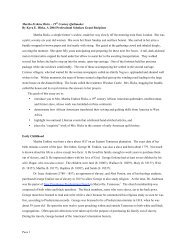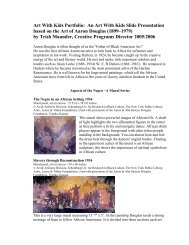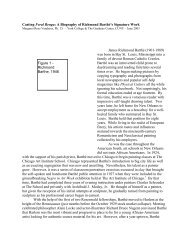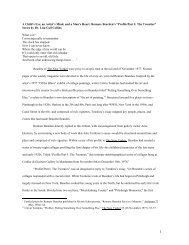Cuesta Benberry - The Anyone Can Fly Foundation, Inc.
Cuesta Benberry - The Anyone Can Fly Foundation, Inc.
Cuesta Benberry - The Anyone Can Fly Foundation, Inc.
Create successful ePaper yourself
Turn your PDF publications into a flip-book with our unique Google optimized e-Paper software.
http://www.oldstatehouse.com/piece%2Dof%2Dmy%2Dsoul/quilting%2Dfamilies/default.asp?fn=<strong>The</strong>+Allen+Sisters+%26+Descendants&fid=1&id=14&qid=4&qn=Hattie+Williams+JonesCUESTA: Yeah. Well. Sometimes they do. I think that that should be noted. <strong>The</strong> onlything is when they transfer that and say that all African-American quilters make largestitches. But then, you can understand why they would make large stitches. Becausethe purpose for which those quilts were made. Those quilts were not made to bebeautiful wall hangings. <strong>The</strong>y were utilitarian and they needed to be made in a hurry.I interviewed a woman right here in St. Louis, she’s since passed, and she made theGrandmother’s flower garden quilt. And that’s that hexagon. And she’s from Mississippi,but her hexagons were big. And most times when you see those quilts Grandmother’sflower gardens are small hexagons. And I asked her, Malverna Richardson, used to liveright out here in Beverly Hills and I used to love to go to her house and interview her.(This is an aside, because she made the best cobbler.) She was such a wonderfulwoman. I loved to go to her house and see her quilts and talk to her. And I asked herabout those hexagons because her hexagons were that big, and most of them are small.She said, “I ain’t no fool. I used to make those little bitty hexagons. But now I makethem big so I can get through and that’s the way it is.”And she was a quilt maker. Oh she made some lovely quilts. I used to love to go to herhouse.FAITH: So you’ve established that African-American quilt makers made quilts in all thedifferent techniques.CUESTA: Yes, yes.FAITH: Some showed technical proficiency better than others, but they embracedeverything that they came about.Figure 4: Butterfly Quilt, ca. 1930. By Authorine Wilson Anderson.Cotton, appliquéd. Collection of Old State House Museum 96.01.7.http://www.oldstatehouse.com/piece-of-my-soul/quiltingfamilies/default.asp?fn=Frances+Smith+Wilson+%26+Descendants&fid=2&id=24&qid=6&qn=Authorine+Wilson+AndersonCUESTA: I think so.FAITH: And for another reason, that’s also true is because they worked during slavery.If they were going to make quilts they were going to have to please the quilt master’shousehold – whatever they wanted. Now for their own quilts, they could make those theway they wanted to. But they had to know these other ways. And I think maybe youcould tell us about this. What were the dominant styles during slavery that they used tomake quilts for the master’s house?page 6






